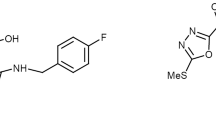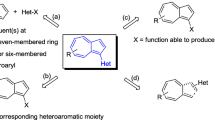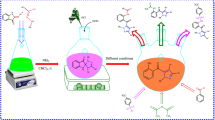Abstract
An efficient protocol providing easy access to highly functionalized heterocyclic compounds as novel organic building blocks was developed by coupling alkyl pyrazole-, indazole- and indolecarboxylates with N-Boc-3-iodoazetidine. The synthesized compounds are representatives of constrained non-chiral synthetic azole carboxylates in their N-Boc protected ester forms. Diversification of the prepared heterocyclic building blocks was achieved via application of palladium-catalyzed Suzuki–Miyaura cross-coupling reactions. In total, 34 building blocks were obtained to form a highly diversified small molecule collection. The structure of the novel heterocyclic compounds was investigated and verified by advanced NMR spectroscopy methods.
Graphic abstract














Similar content being viewed by others
References
Walsh CT, O’Brien RV, Khosla C (2013) Nonproteinogenic amino acid building blocks for nonribosomal peptide and hybrid polyketide scaffolds. Angew Chemie Int Ed 52:7098–7124. https://doi.org/10.1002/anie.201208344
Grauer A, König B (2009) Peptidomimetics—a versatile route to biologically active compounds. Eur J Org Chem. https://doi.org/10.1002/ejoc.200900599
Ishida H, Kyakuno M, Oishi S (2004) Molecular design of functional peptides by utilizing unnatural amino acids: toward artificial and photofunctional protein. Biopolym Pept Sci Sect 76:69–82. https://doi.org/10.1002/bip.10581
Žukauskaite A, Moretto A, Peggion C et al (2014) Synthesis and conformational study of model peptides containing N-substituted 3-aminoazetidine-3-carboxylic acids. Eur J Org Chem 2014:2312–2321. https://doi.org/10.1002/ejoc.201301741
Hecht S, Huc I (2007) Foldamers: structure, properties, and applications. Wiley, Weinheim
Hodgson DRW, Sanderson JM (2004) The synthesis of peptides and proteins containing non-natural amino acids. Chem Soc Rev 33:422. https://doi.org/10.1039/b312953p
Petersen LK, Blakskjær P, Chaikuad A et al (2016) Novel p38α MAP kinase inhibitors identified from yoctoReactor DNA-encoded small molecule library. Medchemcomm 7:1332–1339. https://doi.org/10.1039/c6md00241b
Hansen MH, Blakskjaer P, Petersen LK et al (2009) A yoctoliter-scale DNA reactor for small-molecule evolution. J Am Chem Soc 131:1322–1327. https://doi.org/10.1021/ja808558a
Zimmermann G, Neri D (2016) DNA-encoded chemical libraries: foundations and applications in lead discovery. Drug Discov Today 21:1828–1834. https://doi.org/10.1016/j.drudis.2016.07.013
Shi B, Zhou Y, Huang Y et al (2017) Recent advances on the encoding and selection methods of DNA-encoded chemical library. Bioorganic Med Chem Lett 27:361–369. https://doi.org/10.1016/j.bmcl.2016.12.025
Sardina FJ, Rapoport H (2002) Enantiospecific synthesis of heterocycles from α-Amino Acids. Chem Rev 96:1825–1872. https://doi.org/10.1021/cr9300348
Singh P, Samanta K, Das SK, Panda G (2014) Amino acid chirons: a tool for asymmetric synthesis of heterocycles. Org Biomol Chem 12:6297–6339. https://doi.org/10.1039/c4ob00943f
Heravi MM, Vavsari VF (2015) Recent applications of intramolecular Diels-Alder reaction in total synthesis of natural products. RSC Adv 5:50890–50912. https://doi.org/10.1039/c5ra08306k
Hughes AB (2010) Amino acids, peptides and proteins in organic chemistry. Wiley, Weinheim, p 83
Galloway WRJD, Isidro-Llobet A, Spring DR (2010) Diversity-oriented synthesis as a tool for the discovery of novel biologically active small molecules. Nat Commun 1:80. https://doi.org/10.1038/ncomms1081
Lipinski CA, Lombardo F, Dominy BW, Feeney PJ (2012) Experimental and computational approaches to estimate solubility and permeability in drug discovery and development settings. Adv Drug Deliv Rev 64:4–17. https://doi.org/10.1016/j.addr.2012.09.019
Veber DF, Johnson SR, Cheng H-Y et al (2002) Molecular properties that influence the oral bioavailability of drug candidates. J Med Chem 45:2615–2623. https://doi.org/10.1021/jm020017n
Ansari A, Ali A, Asif M, Shamsuzzaman (2016) Review: biologically active pyrazole derivatives. New J Chem 41:16–41. https://doi.org/10.1039/c6nj03181a
Küçükgüzel G, ŞenkardeŞ S (2015) Recent advances in bioactive pyrazoles. Eur J Med Chem 97:786–815. https://doi.org/10.1016/j.ejmech.2014.11.059
Karrouchi K, Radi S, Ramli Y et al (2018) Synthesis and pharmacological activities of Pyrazole derivatives: a review. Molecules. https://doi.org/10.3390/molecules23010134
Naim M, Alam O, Nawaz F et al (2015) Current status of pyrazole and its biological activities. J Pharm Bioallied Sci 8:2. https://doi.org/10.4103/0975-7406.171694
Kumar V, Kaur K, Gupta GK, Sharma AK (2013) Pyrazole containing natural products: synthetic preview and biological significance. Eur J Med Chem 69:735–753. https://doi.org/10.1016/j.ejmech.2013.08.053
Gilfillan L, Artschwager R, Harkiss AH et al (2015) Synthesis of pyrazole containing α-amino acids via a highly regioselective condensation/aza-Michael reaction of β-aryl α, β-unsaturated ketones. Org Biomol Chem 13:4514–4523. https://doi.org/10.1039/c5ob00364d
Velíšek J, Cejpek K (2006) Biosynthesis of food constituents: amino acids: aromatic and heterocyclic amino acids groups—a review. Czech J Food Sci 24:93–109. https://doi.org/10.17221/3304-CJFS
Jørgensen CG, Bräuner-Osborne H, Nielsen B et al (2007) Novel 5-substituted 1-pyrazolol analogues of ibotenic acid: synthesis and pharmacology at glutamate receptors. Bioorgan Med Chem 15:3524–3538. https://doi.org/10.1016/j.bmc.2007.02.047
Conti P, Pinto A, Tamborini L et al (2010) Novel 3-carboxy-and 3-phosphonopyrazoline amino acids as potent and selective NMDA receptor antagonists: design, synthesis, and pharmacological characterization. ChemMedChem 5:1465–1475. https://doi.org/10.1002/cmdc.201000184
Faust MR, Höfner G, Pabel J, Wanner KT (2010) Azetidine derivatives as novel γ-aminobutyric acid uptake inhibitors: synthesis, biological evaluation, and structure-activity relationship. Eur J Med Chem 45:2453–2466. https://doi.org/10.1016/j.ejmech.2010.02.029
Mangelinckx S, Žukauskaite A, Buinauskaite V et al (2008) Synthesis of alkyl 2-(bromomethyl)aziridine-2-carboxylates and alkyl 3-bromoazetidine-3-carboxylates as amino acid building blocks. Tetrahedron Lett 49:6896–6900. https://doi.org/10.1016/j.tetlet.2008.09.119
Žukauskaite A, Mangelinckx S, Buinauskaite V et al (2011) Synthesis of new functionalized aziridine-2- and azetidine-3-carboxylic acid derivatives of potential interest for biological and foldameric applications. Amino Acids. https://doi.org/10.1007/s00726-011-0879-1
Sada T, Saito H (2004) Pharmacological profiles and clinical effects of azelnidipine, a long-acting calcium channel blocker. Folia Pharmacol Jpn 122:539–547. https://doi.org/10.1254/fpj.122.539
Fletcher S (2015) The Mitsunobu reaction in the 21st century. Org Chem Front 2:739–752. https://doi.org/10.1039/c5qo00016e
But TYS, Toy PH (2007) The Mitsunobu reaction: origin, mechanism, improvements, and applications. Chem Asian J 2:1340–1355. https://doi.org/10.1002/asia.200700182
Cho JH, Coats SJ, Schinazi RF (2015) Synthesis of carbocyclic nucleoside analogs with five-membered heterocyclic nucleobases. Tetrahedron Lett 56:3587–3590. https://doi.org/10.1016/j.tetlet.2015.01.051
Almena I, Díaz-Barra E, de la Hoz A et al (1998) Alkylation and arylation of pyrazoles under solvent-free conditions: Conventional heating versus microwave irradiation. J Heterocycl Chem 35:1263–1268. https://doi.org/10.1002/jhet.5570350604
Huang A, Wo K, Lee SYC et al (2017) Regioselective synthesis, NMR, and crystallographic analysis of N1-substituted pyrazoles. J Org Chem 82:8864–8872. https://doi.org/10.1021/acs.joc.7b01006
Harrison RJ, Warren M, Owenford S, Ramsden N (2013) Pyrazole compounds as jak inhibitors. Patent US 2013/0131043 A1
Zhang S-G, Liang C-G, Zhang W-H (2018) Recent advances in indazole-containing derivatives: synthesis and biological perspectives. Molecules 23:2783. https://doi.org/10.3390/molecules23112783
Denya I, Malan SF, Joubert J (2018) Indazole derivatives and their therapeutic applications: a patent review (2013–2017). Expert Opin Ther Pat 28:441–453. https://doi.org/10.1080/13543776.2018.1472240
Shrivastava A, Chakraborty AK, Upmanyu N, Singh A (2016) Recent progress in chemistry and biology of indazole and its derivatives: a brief review. Austin J Anal Pharm Chem 3:1–23
Cheung M, Boloor A, Stafford JA (2007) Efficient and regioselective synthesis of 2-Alkyl-2H-indazoles. J Org Chem 68:4093–4095. https://doi.org/10.1021/jo0265434
Hunt KW, Moreno DA, Suiter N et al (2009) Selective synthesis of 1-functionalized-alkyl-1H-indazoles. Org Lett 11:5054–5057. https://doi.org/10.1021/ol902050m
Lin MH, Liu HJ, Lin WC et al (2015) Regioselective synthesis of 2H-indazoles through Ga/Al- and Al-mediated direct alkylation reactions of indazoles. Org Biomol Chem 13:11376–11381. https://doi.org/10.1039/c5ob01747e
Chadha N, Silakari O (2017) Indoles as therapeutics of interest in medicinal chemistry: bird’s eye view. Eur J Med Chem 134:159–184. https://doi.org/10.1016/j.ejmech.2017.04.003
Kaushik NK, Kaushik N, Attri P et al (2013) Biomedical importance of indoles. Molecules 18:6620–6662. https://doi.org/10.3390/molecules18066620
Dunn CJ, Goa KL (2001) Zafirlukast: an update of its pharmacology and therapeutic efficacy in asthma. Drugs 61:285–315. https://doi.org/10.2165/00003495-200161020-00012
Panathur N, Gokhale N, Dalimba U et al (2015) New indole-isoxazolone derivatives: synthesis, characterisation and in vitro SIRT1 inhibition studies. Bioorganic Med Chem Lett 25:2768–2772. https://doi.org/10.1016/j.bmcl.2015.05.015
Badiger J, Manjulatha K, Girish M et al (2009) Synthesis and biological evaluation of some N-substituted indoles. Arkivoc 2009:217–231. https://doi.org/10.3998/ark.5550190.0010.c19
Zicmanis A, Vavilina G, Drozdova S et al (2006) Alkylation of ambident indole anion in ionic liquids. Cent Eur J Chem 5:156–168. https://doi.org/10.2478/s11532-006-0063-8
Kost AN, Yudin LG, Budylin VA (1967) The chemistry of indole. Chem Heterocycl Compd. https://doi.org/10.1007/bf00955590
Cano R, Yus M, Ramón DJ (2013) Environmentally friendly and regioselective C3-alkylation of indoles with alcohols through a hydrogen autotransfer strategy. Tetrahedron Lett 54:3394–3397. https://doi.org/10.1016/j.tetlet.2013.04.062
Heaney H, Ley SV (1973) N-Alkylation of indole and pyrroles in dimethyl sulphoxide. J Chem Soc Perkin Trans 1:499–500. https://doi.org/10.1039/P19730000499
Jorapur YR, Jeong JM, Chi DY (2006) Potassium carbonate as a base for the N-alkylation of indole and pyrrole in ionic liquids. Tetrahedron Lett 47:2435–2438. https://doi.org/10.1016/j.tetlet.2006.01.129
Vilkauskaite G, Krikštolaityte S, Paliulis O et al (2013) Use of tosylated glycerol carbonate to access N-glycerylated aza-aromatic species. Tetrahedron 69:3721–3727. https://doi.org/10.1016/j.tet.2013.03.002
Beletskaya IP, Alonso F, Tyurin V (2019) The Suzuki–Miyaura reaction after the Nobel prize. Coord Chem Rev 385:137–173. https://doi.org/10.1016/j.ccr.2019.01.012
Düfert MA, Billingsley KL, Buchwald SL (2013) Suzuki-miyaura cross-coupling of unprotected, nitrogen-rich heterocycles: substrate scope and mechanistic investigation. J Am Chem Soc 135:12877–12885. https://doi.org/10.1021/ja4064469
Channar PA, Saeed A, Larik FA et al (2018) Synthesis of aryl pyrazole via Suzuki coupling reaction, in vitro mushroom tyrosinase enzyme inhibition assay and in silico comparative molecular docking analysis with Kojic acid. Bioorg Chem 79:293–300. https://doi.org/10.1016/j.bioorg.2018.04.026
Jedinák L, Zátopková R, Zemánková H et al (2017) The Suzuki–Miyaura cross-coupling reaction of halogenated aminopyrazoles: method development, scope, and mechanism of dehalogenation side reaction. J Org Chem 82:157–169. https://doi.org/10.1021/acs.joc.6b02306
Cheng H, Wu QY, Han F, Yang GF (2014) Efficient synthesis of 4-substituted pyrazole via microwave-promoted Suzuki cross-coupling reaction. Chin Chem Lett 25:705–709. https://doi.org/10.1016/j.cclet.2014.03.013
Arbačiauskiene E, Vilkauskaite G, Eller GA et al (2009) Pd-catalyzed cross-coupling reactions of halogenated 1-phenylpyrazol-3-ols and related triflates. Tetrahedron 65:7817–7824. https://doi.org/10.1016/j.tet.2009.07.017
Arbačiauskiene E, Martynaitis V, Krikštolaityte S et al (2011) Synthesis of 3-substituted 1-phenyl-1H-pyrazole-4-carbaldehydes and the corresponding ethanones by Pd-catalysed cross-coupling reactions. Arkivoc 2011:1–21. https://doi.org/10.3998/ark.5550190.0012.b01
Arbačiauskiene E, Vilkauskaite G, Šačkus A, Holzer W (2011) Ethyl 3- and 5-triflyloxy-1H-pyrazole-4-carboxylates in the synthesis of condensed pyrazoles by Pd-catalysed cross-coupling reactions. Eur J Org Chem. https://doi.org/10.1002/ejoc.201001560
Boulton BE, Coller BAW (1971) Kinetics, stoicheiometry, and mechanism in the bromination of aromatic heterocycles:i. Aqueous bromination of pyrazole, 1-methylpyrazole, and 3,5-dimethylpyrazole. Aust J Chem 24:1413–1423. https://doi.org/10.1071/CH9711413
Zhao ZG, Wang ZX (2007) Halogenation of pyrazoles using N-halosuccinimides in CCl4 and in water. Synth Commun 37:137–147. https://doi.org/10.1080/00397910600978549
Stefani HA, Pereira CMP, Almeida RB et al (2005) A mild and efficient method for halogenation of 3,5-dimethyl pyrazoles by ultrasound irradiation using N-halosuccinimides. Tetrahedron Lett 46:6833–6837. https://doi.org/10.1016/j.tetlet.2005.08.027
Lyalin BV, Petrosyan VA, Ugrak BI (2010) Electrosynthesis of 4-bromosubstituted pyrazole and its derivatives. Russ J Electrochem 46:123–129. https://doi.org/10.1134/s1023193510020011
Lyalin BV, Petrosyan VA (2014) The reactivity trends in electrochemical chlorination and bromination of N-substituted and N-unsubstituted pyrazoles. Chem Heterocycl Compd 49:1599–1610. https://doi.org/10.1007/s10593-014-1411-9
Janin YL (2013) Preparations of 4-substituted 3-carboxypyrazoles. J Heterocycl Chem 50:1410–1414. https://doi.org/10.1002/jhet.1654
Braun S, Kalinowski H-O, Berger S (2000) 150 and more basic NMR experiments: a practical course, 2nd edn. ACS, New York
Senior MM, Williamson RT, Martin GE (2013) Using HMBC and ADEQUATE NMR data to define and differentiate long-range coupling pathways: is the Crews rule obsolete? J Nat Prod 76:2088–2093. https://doi.org/10.1021/np400562u
Williamson RT, Buevich AV, Martin GE, Parella T (2014) LR-HSQMBC: a sensitive NMR technique to probe very long-range heteronuclear coupling pathways. J Org Chem 79:3887–3894. https://doi.org/10.1021/jo500333u
Sanz SIA, Nez Š, Jimeno MAL (1997) Parameters of Azoles. Magn Reson Chem 35:35–75. https://doi.org/10.1002/(SICI)1097-458X(199701)35:1<35::AID-OMR25>3.0.CO;2-K
Bieliauskas A, Krikštolaityte S, Holzer W, Šackus A (2018) Ring-closing metathesis as a key step to construct the 2, 6-dihydropyrano[2,3-c]pyrazole ring system. Arkivoc 2018:296–307. https://doi.org/10.24820/ark.5550190.p010.407
Arbačiauskiene E, Tolaityte SK, Mitrulevičiene A et al (2018) On the Tautomerism of N-Substituted Pyrazolones: 1,2-Dihydro-3H-pyrazol-3-ones versus 1H-Pyrazol-3-ols. Molecules 23:129. https://doi.org/10.3390/molecules23010129
Martin GE (2011) Using 1,1- and 1,n-ADEQUATE 2D NMR data in structure elucidation protocols. In: Annual reports on NMR spectroscopy, pp 215–291
Sedaghat Doost A, Akbari M, Stevens CV et al (2019) A review on nuclear overhauser enhancement (NOE) and rotating-frame overhauser effect (ROE) NMR techniques in food science: basic principles and applications. Trends Food Sci Technol 86:16–24. https://doi.org/10.1016/j.tifs.2019.02.001
Acknowledgements
This work has been accomplished with financial support provided by Vipergen ApS company (Copenhagen, Denmark).
Author information
Authors and Affiliations
Corresponding author
Additional information
Publisher's Note
Springer Nature remains neutral with regard to jurisdictional claims in published maps and institutional affiliations.
Rights and permissions
About this article
Cite this article
Iškauskienė, M., Ragaitė, G., Sløk, F.A. et al. Facile synthesis of novel amino acid-like building blocks by N-alkylation of heterocyclic carboxylates with N-Boc-3-iodoazetidine. Mol Divers 24, 1235–1251 (2020). https://doi.org/10.1007/s11030-019-09987-8
Received:
Accepted:
Published:
Issue Date:
DOI: https://doi.org/10.1007/s11030-019-09987-8




